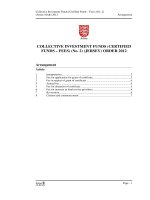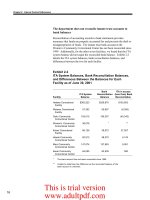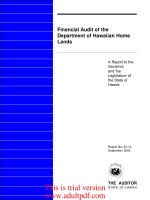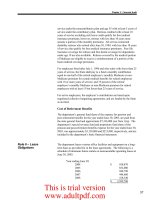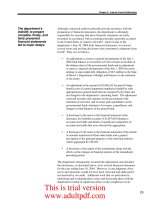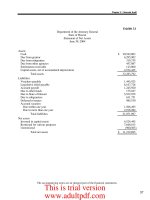No bull investing straightforward advice_2 ppt
Bạn đang xem bản rút gọn của tài liệu. Xem và tải ngay bản đầy đủ của tài liệu tại đây (159.37 KB, 23 trang )
Contrary Opinion Is One of the
Most Important Tools to Success
The contemporary way of saying this is “Think outside the
box.” In other words, you will want to go contrary to the crowd
most of the time. This won’t make you feel too good, and it
won’t rest well with some of your friends, family, or associates. By
“contrary opinion,” I mean simply that you must assess the pre-
vailing majority opinion, and you must be willing to think and
DO the opposite. When most people are afraid to buy stocks or
to begin a certain type of business, then you must seriously con-
sider buying stocks or starting a business.
When most people are convinced that things are good, and
that the good times will never end, you must take actions that
will serve you well when the good times do end. When most peo-
ple are panicking, you must be calm and collected, taking logical
steps instead of reacting irrationally. When most people are pessi-
mistic, you want to be an optimist. There are literally hundreds
of examples in business where contrary opinion paid big divi-
dends. The most recent example was the much-vaunted, much-
feared “Y2K bug,” which was supposed to bring with it financial
chaos, the collapse of the power grid, anarchy, mass confusion,
and worse. Some of the most well-known analysts, politicians, and
scientists staked their reputations on the belief that cataclysmic
events—socially, politically, economically, and technologically—
would happen when the new millennium started. And nothing
happened.
We were warned by the prophets of gloom and doom that
banks might close down, that we might not have electricity, that
we might not be able to have medical prescriptions filled, and
that food distribution would stop or be curtailed. The Y2K bug
was one of the most obvious examples of how panic can be
14 NO BULL INVESTING
infectious. If you’d like more examples, read McKay’s Extraordi-
nary Popular Delusions and the Madness of Crowds (Xlibris Corp.,
30 November 2000).
I’ll make it very simple and straightforward for you: What
most people think is wrong and when most people are thinking
one way, odds are that events will develop the opposite way. Yes,
it will be very difficult for you to be a contrary thinker, but it can
yield great rewards.
You Have to Think for Yourself
This seems very obvious, doesn’t it? We all want to believe
that we think for ourselves. In truth, we are brainwashed daily by
the media, by newspapers, and by friends, family, and those we
love. Does this mean that you should not read newspapers, watch
television, or listen to the radio? Should you also disrespect those
you love? Not at all! The answer is simple: Develop your ideas in-
dependently, evaluating all other ideas and statements within
the framework of what you believe yourself. It’s easy to be influ-
enced by other people, especially if you love and respect them.
The sophisticated, intelligent-looking, smooth-talking anchor-
person on business television or the nightly news may appear to
know what he or she is talking about. The odds are that they
know nothing more than what they’re reading. Their script has
been prepared for them; they’re merely reading the words that
other people have written for them. Who are these other peo-
ple? Do they have hidden agendas? Do they know what they’re
talking about? Are they merely reflecting the opinions of oth-
ers? You’ll find that most of the time their thinking is very stan-
dard, very average, and very wrong. So, remember to think for
yourself!
WANT TO MAKE MORE MONEY? DO THESE THINGS FIRST 15
The More Complicated Your Methodology,
the Less Likely It Is to Work
During my more than 30 years in the investment field, I have
seen literally hundreds, if not thousands, of trading strategies,
investment schemes, programs, multilevel marketing programs,
Internet sales programs, computer trading programs, real estate
methods, and more. Most of them don’t work. And the ones
that are the most complicated seem to be the least successful. Al-
though it has likely been grossly overused, the “Keep It Simple,
Stupid,” or KISS, rule is still one of the best rules you can learn.
You don’t need a degree in economics or business to make money
as an investor. All you need is a plan, some rules, motivation, some
money, discipline, and consistency.
These, then, are the universal truths I discovered during my
lengthy search for methods that would make me financially in-
dependent. I will elaborate on them throughout the course of
this book. Rest assured that if you learn them and apply them to
any business, investment plan, or trading program, they will
serve you well. Ignore them, and you will be destined to learn
the same lessons over and over until you finally get them right!
Many Roads Lead to Success
This book is not just about the stock market; it will give you
a general formula for making money in any market, whether real
estate, rare coins, options, futures, single stock futures, bonds,
mutual funds, or other moneymaking ventures. The way I will
achieve this goal is by providing you with concepts, structure, ex-
amples, and a general model you can follow. The model will serve
you well as long as you use it. It will not serve you, if you try to
16 NO BULL INVESTING
sidestep it or change it. I will also give you specific examples of
how to put your plan for financial freedom into action.
As we move forward and explore the various avenues and
methods by which you can achieve your goals and realize your
dreams, know that the journey ahead will not be an easy one.
Success will not “fall out of a magazine.” It will take work and ef-
fort, but vast rewards await you. In fact, you may even enjoy the
challenge. Remember that attaining and maintaining success re-
quire a diversified approach. Keep the big picture in mind as
you specialize in one area or in one type of investment, because
there are other aspects of investing and financial planning that
will need your attention as well. All too often, individuals focus
on a single aspect of investing and make good money, but fail to
plan ahead. The result is that they lose money either to taxes
and inflation or in other investments they should not have ven-
tured into without full information and knowledge. In short,
you have to learn how to make money, how to keep it, how to
make it grow, how to protect it, and how to spend it wisely.
WANT TO MAKE MORE MONEY? DO THESE THINGS FIRST 17
18 NO BULL INVESTING
CHAPTER TWO
BEGINNINGS, DANGERS,
AND DIRECTIONS
No matter how you look at it, investing always involves some
degree of risk or danger. You can’t get ahead unless you’re will-
ing to take some risk. There are many forms of risk, however.
You can risk your money or your time. You can risk your physi-
cal and mental health. You can risk your relationships. Although
many people may believe that the only risk in investing is
money, I can tell you from many years of experience that they
are wrong. Investing carries many risks. These risks increase as a
function of who you are, how you invest, how you view your in-
vestments, and how you handle your life in general. It is not pos-
sible to separate the investment from the investor. Two investors
can have the same ideas about the same investments, and they
can achieve distinctly different results depending on how they
put their plans into action. Two people looking at the same infor-
mation will not necessarily reach the same conclusions. That’s why
there are buyers and sellers in any market. A piece of property
19
that may seem expensive to one person may be an amazing bar-
gain to another. Where opportunities abound for some people,
only risk of loss exists for others.
The first thing you must know about making your money
grow and becoming financially independent is that there is and
will always be some degree of risk. Yes, you can lose money. But
what will it cost you to not take some risk? Will stress force you
to take losses in another way? Are you willing to accept the phys-
ical stress of working several jobs and long hours to make ends
meet? Are you willing to accept the stress that long hours will
exact on your family relationships? Are you willing to accept the
emotional stress, anxiety, and pressure that occur when you
can’t pay the rent on time? All of these are forms of losses. You
can either accept these losses, or you can take the risk of a fi-
nancial loss as a means of avoiding other types of losses. The de-
cision is yours. Either you take one type of risk to avoid another,
or you accept the losses that may occur as a result of having in-
sufficient money to support yourself and your family.
OF COURSE YOU WANT TO TAKE
IMMEDIATE ACTION!
Perhaps I struck a chord in your thinking, and you spent
some time considering your situation. After consideration, have
you decided that there is some merit to my view? Have you de-
cided that you want to become financially independent? Maybe
I convinced you that you can indeed do it yourself, that you
don’t need an education in finance or a broker to advise you. In
short, are you willing to take the chance?
If you have decided to take action, then stop for a moment
and think. Some people want to act immediately; in fact, they
20 NO BULL INVESTING
want to act too quickly. Learning how to make your money grow
is not like learning to play a game of Monopoly. Learning how
to make your money grow cannot be achieved by sitting in a
one-hour class or seminar on investing. It’s not as simple as fol-
lowing the advice in a newsletter or taking a stock tip from a
friend or relative. But it is not nearly as complicated as you
might think. One thing you will need to remember: Take your
time. Don’t rush into investing simply because you feel financial
pressure. I have observed that many people do more research
when buying a television than they do making an investment.
Moving too quickly can cause mistakes, and investment mistakes
will cost you money.
THE DANGERS OF MOVING
TOO SLOWLY
There is also danger in taking too much time. After all, book
learning can only take you so far; you’ll have to get your feet wet
sooner or later. Sooner or later you will have to invest some real
money, even if it’s only a few hundred dollars. You will have to
put your knowledge to work eventually. Unfortunately, many
would-be investors freeze up when it comes time to make the
fateful decision. They believe that they need more information,
that they have not learned enough. They hide behind their feel-
ings of ignorance in order to avoid taking the leap. The fact is
that they are afraid to lose money, and they believe the best way
to avoid losing money is to be absolutely certain of their deci-
sion. Although it’s a good idea to take your time, it’s a bad idea
to take too much time. Don’t rush into an investment, but don’t
become an eternal student, either.
BEGINNINGS, DANGERS, AND DIRECTIONS 21
DO IT ALONE OR GET A PARTNER?
Now you must make yet another decision before you begin to
invest your money. You must decide whether you will learn the
business of investing on your own or with a partner. There are good
points and bad points about each of these avenues. I will examine
these more fully in Chapter 9, but for now consider these points:
Ⅲ Working with a partner allows you to share in your enthu-
siasm.
Ⅲ A partner can help you remain motivated.
Ⅲ Working with a partner can be beneficial, because you can
pool your financial resources.
Ⅲ Your decisions can be double-checked if you have a partner.
Ⅲ A partner can provide meaningful input about things you
may not have seen.
Ⅲ A partner can help you maintain discipline.
On the other hand, there can be a downside to working with
a partner. Consider these potential limitations of working with a
partner:
Ⅲ You may have a personality conflict or clash with a partner.
Ⅲ Your own good judgment could be adversely affected by
working with a partner.
Ⅲ You may end up quarreling with your partner about prof-
its and/or losses.
Ⅲ Sometimes, opinions can become infectious, particularly
if your partner is highly persuasive. If his or her ideas or
22 NO BULL INVESTING
analyses of the facts are wrong, you may get fooled into
going along with him or her and lose money as well.
Your partner need not be a business associate or a friend.
You can embark on your investment plan with a spouse or even
a close friend. Remember, however, that sometimes being too
involved with your partner outside your investment relationship
can lead to problems. Some of these are discussed in Chapter 3.
A CHECKLIST FOR SUCCESSFUL PREPARATION
I have spent considerable time in this chapter discussing the
importance of effective and thorough preparation. I have given
you some ideas about directions to take, as well as which assets
and possible liabilities of the numerous alternatives are available
to you as an investor. Here is a ten-item checklist that may help
you in the planning stages. I suggest that you consider these
points carefully within the framework of who you are and what
you want to accomplish as an investor.
1. Are You Willing to Make the Commitment?
This is the single most important point on my list. If you
can’t make the commitment to begin your plan and, most im-
portant, to stay with it for at least several years, then you may as
well take your money and gamble with it. Odds are that you
won’t be successful as an investor other than by pure luck. You
will need to make money the “good old-fashioned way.” You’ll
have to earn it. The good news is threefold: if you make the
commitment and keep it, you won’t have to work hard, the work
will be enjoyable, and your odds of success will be significant.
BEGINNINGS, DANGERS, AND DIRECTIONS 23
2. Is the Money You Plan to Invest Risk Capital or
Vital to Your Financial Survival?
You can’t succeed if you’re playing with “scared money”; that
is, money you are afraid to lose or may need to make a car pay-
ment or pay the rent. Although your goal as an investor is to
make your money grow as strongly and as quickly as possible,
there will always be the risk of loss. Unless you can accept this
fact, your probability of success will be low indeed. Simply stated:
The money you have allocated to investing is not to be used for
any other purpose, until you have achieved a reasonable degree
of success. If you can’t afford to play the game, you owe it to your-
self to avoid becoming involved in the venture! Even if you can
only afford $25 per month, you can become an investor. Your
progress will be slower than if you start with more money, but
the important thing is just to begin.
3. Determine Where You Stand in Terms of
Your Individual Needs and Goals
The right investments for a retired automobile worker may
not be the right investments for a 35-year-old surgeon. The right
investments for a college student who has a part-time job may
not be the right investments for a middle-aged housewife who
runs a small business part-time out of her home. The right in-
vestments for someone who earns over $500,000 per year may
not be the right investments for an individual whose income is
in the $100,000-per-year range. Because everyone has different
experiences, risk tolerance, available investment capital, family
situations, tax considerations, obligations, and temperaments,
what constitutes an appropriate investment plan will vary con-
siderably from one individual to the next. No one book, course,
24 NO BULL INVESTING
or seminar can give you everything you need. However, if you
study the general models and techniques presented here, you will
likely fare well no matter what specific investments you make
within the limits and needs of your situation. Knowing where
you stand, what you need, and how you plan to get there is of
primary importance. This book provides numerous suggestions
and directions for accomplishing this goal.
4. Do You Have the Time to Follow Through
on Your Commitment?
People are so busy these days. They rush to work and rush
home. They run to catch the train, eat lunch quickly—often at
their desk while working—and rush from the office or the as-
sembly line to the gym. They hurry to the supermarket and then
home to throw something together for dinner. They carpool for
the kids and take them to after-school activities, overnights with
their friends, Boy Scouts, Girl Scouts, school choir, karate, and
even Sunday school. We argue—rightfully—that we need more
time to enjoy life, to enjoy the fruits of our labors, to go fishing
or skiing, or to take a long cruise. When we add having to spend
time investing our money, it just doesn’t seem fair or right. After
all, we work so hard to get ahead. We give so much to our chil-
dren and our jobs and families.
Why should we have to add yet another significant responsi-
bility to our list of chores? The simple answer to this reasonable
and perennial question is: There is time, and everyone can afford
to set aside several hours a week to plan for his or her future.
Time must be budgeted, and priorities need to be established. I
am a firm believer in the fact that children, as much as we may
love them, cannot take all of our time. I have seen too many peo-
ple give too much and then become bitter about not having
BEGINNINGS, DANGERS, AND DIRECTIONS 25
enough time for themselves. I have been guilty of doing so my-
self. Remember that without proper planning and investing,
you may be limiting the ability of your children to attend the
college or professional school of their choice. When you plan
and implement your investments, you’re doing so not only for
your retirement but also for your children’s future.
If you are single and don’t have children, then you may need
to cut back a bit on your social life if you want to ensure a finan-
cially secure future for yourself. No matter what your situation
or position in life, you can find the time to plan your invest-
ments. As in the case of having sufficient investment capital,
having the time can be adjusted to your needs. You say you don’t
have two hours a week—no problem. How about one hour a
week? Or 30 minutes? If you can’t spend a few hours a week,
then go more slowly and spend 30 minutes a week. If you can’t
find 15 minutes a week to do your homework on investing, then
don’t even bother reading the rest of this book. That’s the real-
ity of the situation!
5. Be Consistent, Organized, and Thorough
in All You Do
Perhaps you are a disorganized person, as I am. Perhaps your
desk is piled high with papers, notes, books, and mail. Maybe
you have not mastered the skills of organization and follow-
through. If you believe, as I do, that disorganization will limit or
even prevent you from being successful, then you will have the
incentive to make changes. Note that I am not suggesting a com-
plete change in your life. You can continue to be a disorganized,
messy person in all else you do, but when it comes to investing,
you will need to change. And you’ll need to change sooner
rather than later.
26 NO BULL INVESTING
If there is any one aspect of investing that can be facilitated
with the assistance of a partner, it is the area of organization. If
you don’t have what it takes to be consistent and organized, then
I urge you to find a partner who possesses these skills. As you
continue to read this book and become more experienced as an
investor, you will appreciate more fully the benefits of being or-
ganized. If you decide to work with a partner, then make certain
that you choose your partner carefully and with forethought.
Don’t be afraid to interview potential partners and set specific
ground rules before you get started, in order to make certain
that he or she possesses the skills that will complement yours.
6. Out with the Old and in with the New
To a given extent, most of us are victims of the traditional ap-
proach to investing. In other words, we have been indoctrinated
to view investing in a particular way. The usual approach to in-
vesting is perpetuated by economics courses in high school and
college, by popular books, and by financial advisors and stock-
brokers. We have been told that we need to follow the time-
tested principles of investing. Many of these principles are—in
my view—outdated ideas are no longer applicable or effective in
today’s investment environment. For example, investors have
been brainwashed to believe that in order to make money in
stocks, they need to know what a company does.
You need to know the market for its products, its manage-
ment, its financial history and stability, its earnings, its projected
earnings, and much more. You need to know the economic
outlook, the probable direction of interest rates, the potential
effect of domestic and international politics, the degree of pro-
fessional buying or selling in the stocks you want to buy, and
much more. In short, we have been led to believe that the only
BEGINNINGS, DANGERS, AND DIRECTIONS 27
way to make money in stocks—or for that matter, in real estate—
is by becoming a financial expert.
This myth has, I believe, been perpetuated by a financial com-
munity that seeks to make investors dependent on the advice of
their brokers. Whether in the real estate market, stocks, mutual
funds, futures, or options, we have been led to believe that we
need a good broker in order to make money. I suggest that this
is a false assumption and that, in fact, depending on a broker for
advice can, in many cases, lead you to losses rather than profits.
The fact is that there are very few brokers in any field whose
selections and recommendations have a lengthy and profitable
track record. And these individuals are so good at what they do
that they accept only the largest clients who can make their ef-
forts worthwhile financially. In fact, some of the most successful
investors do not depend on brokers for advice. They have be-
come their own experts. Before you accept the traditional ideas,
ask yourself the following questions:
Ⅲ Why do so many people still lose money following the advice
of brokers who are touted as being “good” at what they do?
Ⅲ Why do mutual funds that are managed by individual ex-
perts or teams of experts still decline in value when the
stock market goes down? Isn’t it fair to ask why these experts
cannot minimize declines and still beat the overall market?
Ⅲ Why have so many “top” analysts lost their jobs or fallen
into disrepute for taking money to recommend stocks
that they knew were likely to go bankrupt?
Ⅲ Why have various agencies of the U.S. government fined
major brokerage houses for having a conflict of interest
wherein they recommended worthless stocks in order to
sell them to unsuspecting investors?
28 NO BULL INVESTING
These are only some of the limitations to consider about the
traditional view and methods of investing. The methods you will
learn in this book will help you become an independent inves-
tor, which will help you avoid dependence on brokers, analysts,
and advisors.
7. Be Prepared to Play Your Own Game
All too often your plans to become an independent investor
and increase your wealth will be thwarted by those around you.
I am speaking specifically of family and “friends.” People tend to
get jealous, even over the smallest things. The fact that you are
forging ahead, taking charge, and controlling your financial fu-
ture will cause some of your friends and family to be envious.
They may try to discourage you from investing. They may attempt
to dissuade you by saying that your efforts will amount to noth-
ing but losses. Don’t listen to them! In fact, I urge you to make
your investment plans without telling friends or family (other
than your spouse), because odds are that few people will be sup-
portive. It is best to play your own game and decide what types
of investing you want to do. Gather the knowledge you will need
and then begin your venture (adventure) without announcing,
discussing, or asking permission of friends or family.
8. Don’t Fool Yourself into Thinking You Need
Expensive Computers or Programs
If you allow yourself to believe that an expensive computer
and the latest programs are needed in order to succeed as an in-
vestor, then you are dead wrong! Here is yet another example of
how the average investor has been tricked into believing what
BEGINNINGS, DANGERS, AND DIRECTIONS 29
the professional community wants to sell to investors. The sim-
ple facts are as follows:
Ⅲ A considerable amount of quality investment information
is available via the Internet free of charge. Yes, you will need
a computer to access the Internet information, but you
can do that with the most basic of computers or an Inter-
net café.
Ⅲ An expensive computer, or for that matter, any type of
computer, will not necessarily help you make money if you
cannot use it properly, and if you don’t have the right pro-
grams. Even if you do have the right computer and the
right programs, there is no guarantee you will do better
than if you did all of your work manually without trading
or investing software.
Ⅲ You don’t need a broker to get stock prices. You don’t need
a broker in order to find real estate. And you don’t even
need a broker to invest in stock programs called dividend
reinvestment programs, or DRIPs. You can buy shares in
a company directly from the company itself, bypassing
the broker entirely without paying a penny in brokerage
commissions.
9. Don’t Feel Pressured at Any Time, for Any Reason
If you allow yourself to be pressured into buying or selling
stocks, options, futures, real estate, coins, or any other type of
investment, then you are likely making the wrong decision. You
need to act slowly, diligently with focus and with purpose. If you
feel a significant urgency to make an investment, then you are
likely being influenced by someone else, either a friend or a bro-
30 NO BULL INVESTING
ker, or by something you have heard on the radio, read in the
newspaper, or seen on television. There are thousands of stocks,
millions of properties, and tens of thousands of business oppor-
tunities, none of which will work for you if you don’t take the time
to study, analyze, and act. Such decisions cannot be made quickly
until you have experience and understanding. If you feel pres-
sure to invest, even after reading this book, then you are likely
headed for disaster. My warning holds true for any investment,
at any time, even after you have had significant experience.
10. Be Prepared to Diversify
Although you can seek to become an expert in one very nar-
row area of investing, you are better off if you seek to diversify
your knowledge and investments into several different areas.
Putting all your eggs into one basket will serve you well as long
as that one area is performing well. However, if this one area be-
gins to falter, then you will be left out in the cold without a fall-
back position. Diversification of investments and assets will be
discussed in Chapters 5, 9, and 10.
BEGINNINGS, DANGERS, AND DIRECTIONS 31
32 NO BULL INVESTING
CHAPTER THREE
MARRIAGE, MONEY,
AND FAMILY
By now, you’re hopefully chomping at the bit to learn some of
the investment techniques to which I alluded in Chapters 1 and 2.
I ask you to be patient, so that we can take care of first things first.
If you’re a single person, you can skip this chapter for now, un-
less you have imminent marriage plans. If you’re married, then
I suggest you read this chapter before you begin your investment
plans or, at the very minimum, make your investment plans with
this chapter in mind.
INVESTING AND MARRIAGE ISSUES
Can marriage hurt or help your financial situation? This
chapter will give you some straight talk about the pitfalls of poor
planning and preparation prior to marriage, as well as some de-
tails on how to improve your finances once you’re married. This
33
chapter will tell you how to approach the financial and legal sides
of marriage from a practical and profit-oriented perspective. If
you fail to adequately prepare yourself for the challenges and
opportunities that marriage can provide, you may well fall vic-
tim to its limitations on your success. The power of a two-income
family can be harnessed to produce very large financial gains, or
it can be a drag on your path to success and wealth as well as
early retirement. There are actions you must take either before
you make those wedding vows or shortly afterward. If you’re al-
ready married, then fear not—it’s not too late!
HARNESSING THE SYNERGISM
OF A TWO-INCOME FAMILY
There is no doubt that the two-income family clearly is an
advantage, if you learn to use it properly when you make your
investments. I strongly suggest you consider one of the incomes
for purposes of paying bills, rent, food, and other expenses, and
the other income for investing. Naturally, if the two incomes are
necessary in order to take care of bills and living expenses, then
consider a portion of the second income for investment pur-
poses. As a rule of thumb, I would suggest approximately 25 per-
cent as a minimum for investing. Realistically, this may not be
possible for you. If not, you will need to begin on a much smaller
scale. See Chapter 9 for details. Clearly, the more you can invest
from a second income, the faster you will be able to achieve fi-
nancial independence. Naturally, if you are a “DINK” (dual in-
come no kids), you will have more investment capital. I cannot
stress too strongly the importance of beginning your investment
program before you get married and no later than the first year
of your marriage, when you may have two incomes and no chil-
dren. You may even want to consider delaying parenthood until
34 NO BULL INVESTING
you have built a solid investment foundation with the assistance
of a dual income.
LIFE INSURANCE ON BOTH PARTNERS:
Term, Convertible Term, or Other
The issue of life insurance is a touchy but necessary one.
There are those who claim that life insurance is not necessary if
you’re a good investor. Of course, there are arguments both in
favor of and opposed to this view. There are a number of differ-
ent types of insurance that cover the spectrum from investment-
grade insurance, or whole life insurance, to term insurance on
the other extreme. The investment type of whole life insurance
works on a simple concept. You pay premiums either monthly or
quarterly, and if you die your spouse collects, or vice versa. The
amount of the premium is a function of your age, health, and
the size of the policy you buy. There are various formulas by
which you can compute how much insurance you need based
on your earning power and the financial needs of your family.
Any competent insurance agent can help you with this. He
or she will gladly show you alternatives based on projections.
Generally speaking, these projections are honest and reason-
able based on the information you have given the agent about
yourself and your family. The amount you pay for coverage—the
premium—can vary considerably, so be sure to shop around.
There are many Web sites that can assist you in finding the right
insurance at the lowest price. Remember that with this type of
insurance, you want to be as confident as possible that the com-
pany you are insured with will not go broke. In order to deter-
mine this, you may have to do some research. The cheapest may
not be the best! The good news about this type of policy is that
the money you pay in is an investment.
MARRIAGE, MONEY, AND FAMILY 35
At some time in the future, you will be able to collect what
you paid in, and you may be able to borrow against it. But don’t
expect your investment to grow substantially, because insurance
companies invest very conservatively, and the return will be low.
While life insurance is usually a safe investment, it won’t make
you rich and won’t grow quickly. The good news is that you and
your family will be protected. The key issue with this type of in-
vestment is whether you can make your money grow faster than
the insurance company can, and whether you can still get the
coverage you need.
This is where term insurance comes into play. With term in-
surance, your premiums are much lower than they are with whole
life insurance, but you don’t get anything back. The money goes
down the drain, unless the insured person dies. There are some
tremendous bargains in term insurance. For most individuals,
this is the sensible way to go because the cost is low and the pro-
tection is good. But term insurance will only be to your benefit
if you can take the money you saved by not buying whole life in-
surance and invest it wisely. And that’s a big “if.”
Which Is Right for You?
Although you are not locked into one type of insurance or
another, as you learn how to invest your money (which is the
purpose of this book), you will only need term insurance. And
this is what I recommend. Note also that there are other plans
that fall somewhere between term insurance and whole life. In-
surance companies offer a wide range of alternatives. Here are
some pointers that will, I believe, serve you well, if you have the
financial ability to put them into action:
Ⅲ Take term insurance for yourself and your spouse.
36 NO BULL INVESTING

